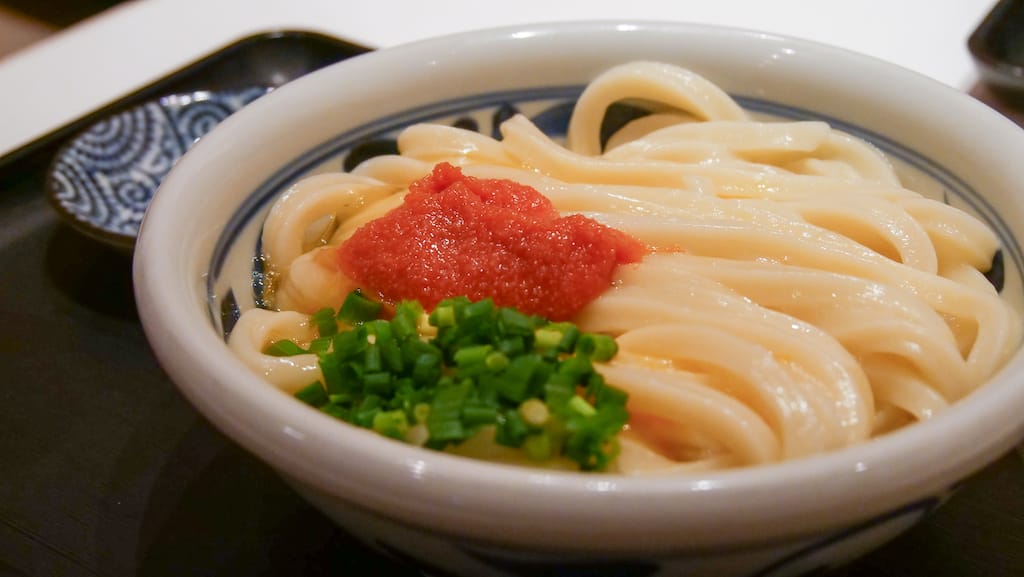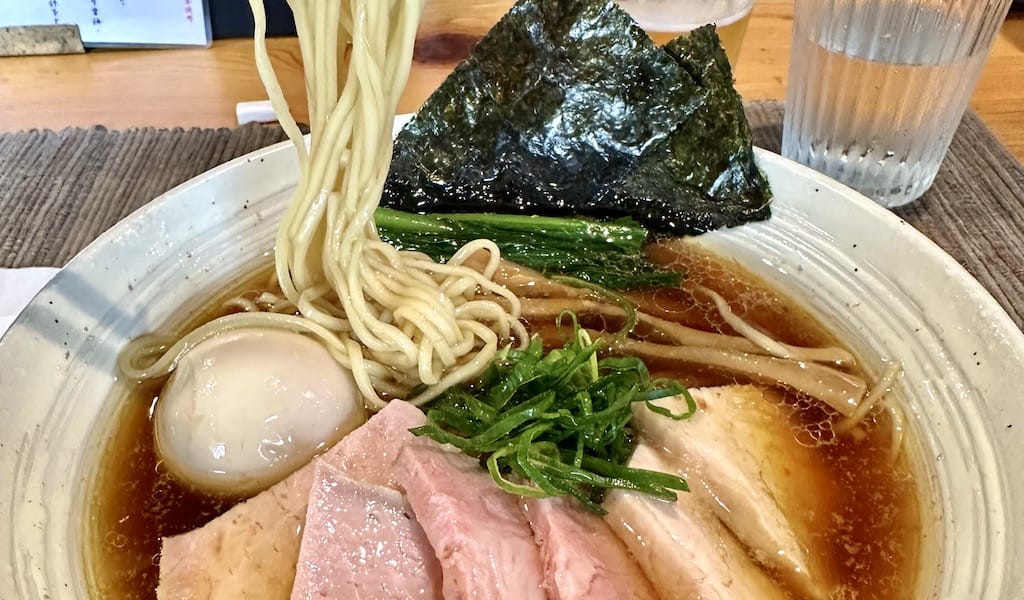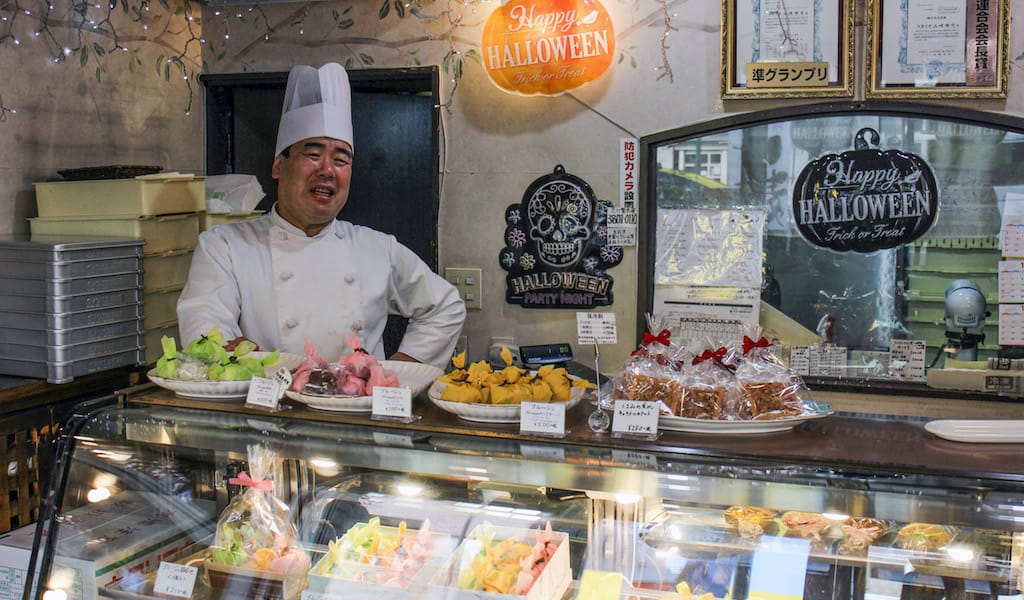The Gion district of Kyoto embodies the romanticism that surrounds Japan’s ancient capital. Filled with machiya (traditional long wooden houses), it harbors several “teahouses,” where geiko — the Kyoto term for geisha – entertain their high-class guests with quick-witted conversation and skilled musical performances.
Yet just north of Shijo Street, the neighborhood evolves into a very different kind of entertainment area. Narrow alleyways are filled with small bars, many of which are kyabakura, hostess clubs that sell the fantasy of female attention. It’s a pocket of Kyoto where one needs confidence or an introduction to open many a door. And it’s also hiding one of the city’s best kept ramen secrets.
Mendori Hyakkei has no visible sign on the street. Instead, hungry ramen seekers must walk a few steps through a building – a kind of short passageway – to where a blue noren (flag) hangs down over a wooden door. Once they push open that door, they are greeted by a scene that could be straight out of a high-end traditional Japanese restaurant. A sleek wooden counter is laid with red lacquerware trays for just eight seats. A simple flower decoration adorns one side. The minimalistic decor conjures a feeling of space that belies the room’s small size.
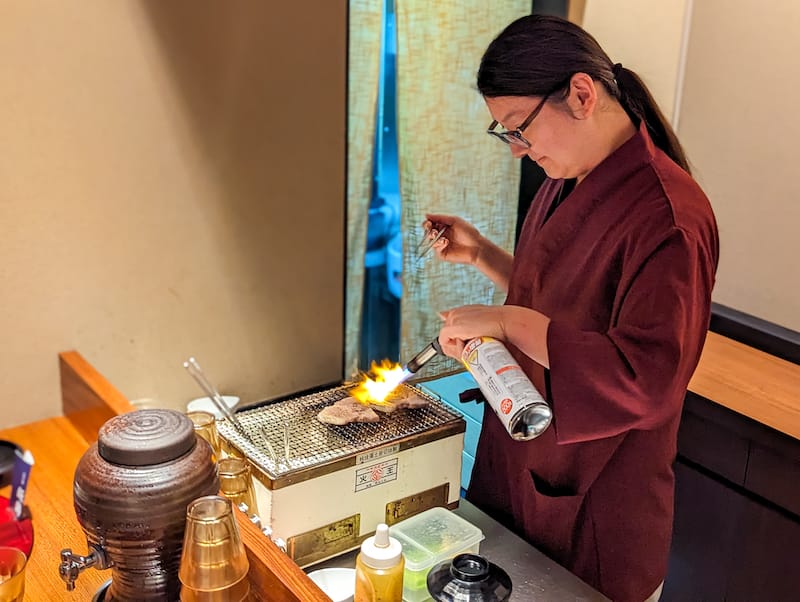
We are those hungry ramen seekers and it’s not without trepidation that we first enter the store. We wonder for a moment if we’ve been mistaken. But a lady behind the counter greets us with a smile and gestures for us to take a seat.
This is Yuki Ofuji, who describes her role as okami, a hostess at traditional Japanese restaurants. She is preparing food for three customers at the counter, who are animatedly chatting and sitting with an ease that only comes from being regulars. They watch Ofuji sear thin strips of chicken for a chicken char siu rice bowl, the blowtorch adding plenty of theatrical flourish. We rush up to take a photo, almost bumping their heads to get a better shot. They laugh and encourage us to watch the performance.
Nothing about Mendori Hyakkei ticks the box of what one would expect at a ramen shop. We wonder, is it really a ramen place? Is this not a secretly members-only dining establishment? Maybe we misread the sign advertising bowls of noodles for just 830 yen (about $5.5)?
Ramen is the opposite of an elegant, refined dining experience. It has its roots as a cheap stomach-filler for laborers in the early 20th century, growing in popularity over the decades to become a quintessential fast food, hangover cure and all-round culinary cultural icon. While it has shaken off its image its junk food image in recent years, with some ramen places opting for better quality ingredients, it still remains a cheap, fast, and efficient meal. It’s said that a bowl should be eaten within ten minutes to avoid the noodles getting soft. But this also supports the underlying business model – ramen stores make their money on covers, and so turnover is key.
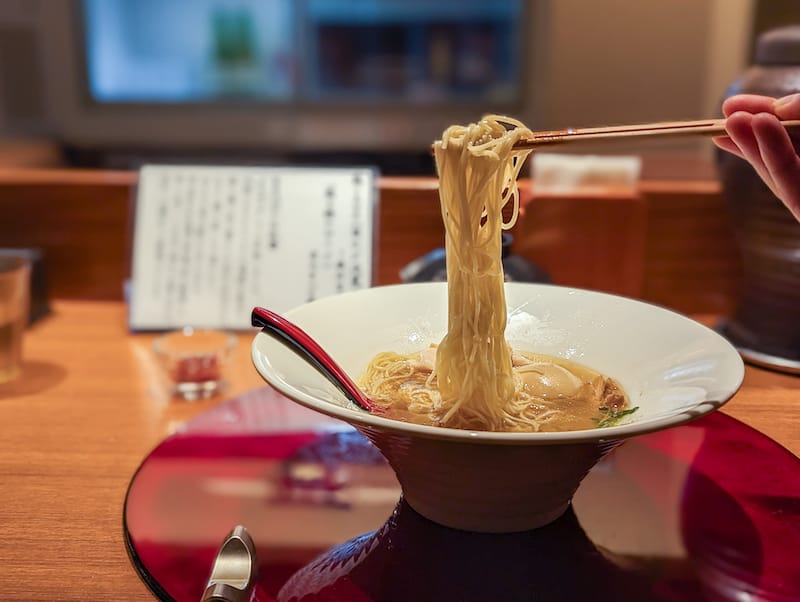
Yet, here at Medori Hyakkei, the atmosphere encourages customers to linger; to appreciate the decor; to step out of the bright, bustling world outside; to take a breather and enjoy a secret culinary show. That’s precisely the goal of owner-chef, Ippei Otsubo.
“It’s a place where, after customers have eaten and gone home, they tell their friends it was delicious and introduce them,” he says. “I’m not really promoting this place. Even for Japanese people, it’s extremely difficult to find. It’s a place where you can talk slowly.”
Otsubo has a frankness in the way he speaks, characteristic of people from his hometown of Osaka. He clearly is someone who does things his way – not to make a point, but simply because he wants to do what he wants to do. He refers to his younger self as a warugaki – a brat, a troublemaker – who ended up working at a Japanese restaurant in Tokyo simply as a way to make ends meet. That restaurant specialized in kappo cuisine, a kind of multi-course meal that showcases seasonal ingredients and Japanese cooking techniques. It’s refined and elegant, and similar to the more well-known kaiseki, although it’s not always quite as high-end.
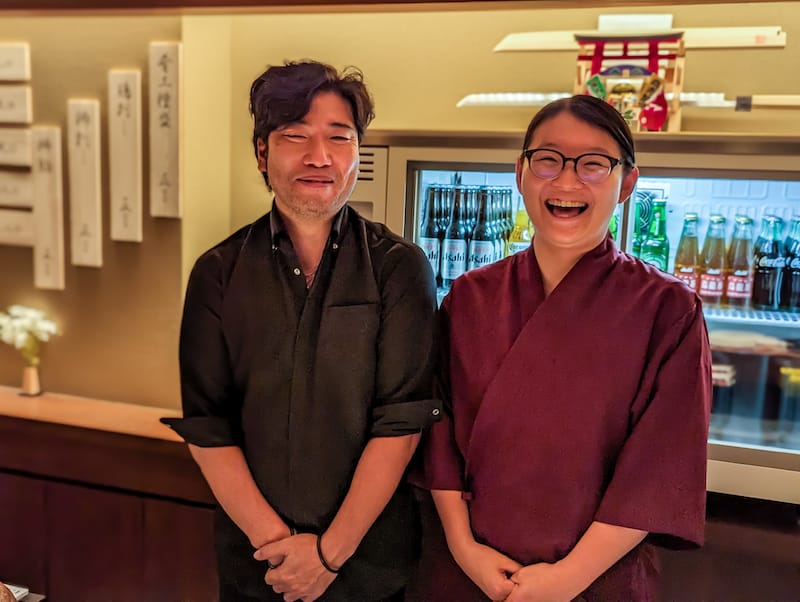
After two decades, however, Otsubo longed to return to the Kansai region from which he’s from and to establish something independently. When he got word that a small space was vacant in the backstreets of Kyoto’s Gion, he seized the chance, launching Mendori Hyalkei in late March 2022.
Here, as with most ramen places, Otsubo has kept the menu relatively simple. There’s asari (clam) broth or tori (chicken) broth, with a choice of shio (salt) or shoyu (soy sauce). He focuses on bringing out the essence of each, using only clams or only chicken to produce the stock.
We decide to compare the chicken versions. Tori shio arrives with a bright, clear soup that reflects its elegant taste. The simple umami of the chicken holds up mouthful after mouthful, never falling flat, but remaining bright and clear, urging us on until the last drop. A quail egg, light pink, adorns the swirl of noodles, and multicolored arare (puffed rice) pepper the bowl with vibrancy. These are not the usual ramen toppings, but they add to the textural-visual treat.
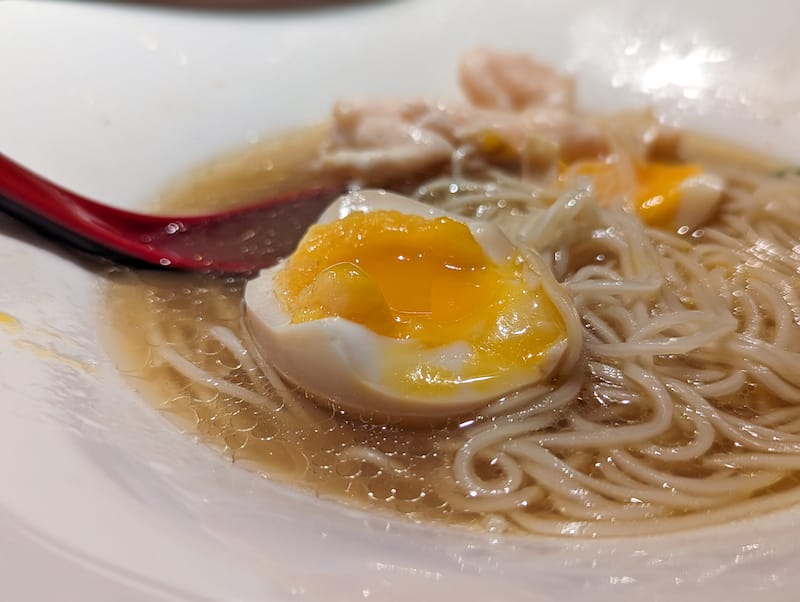
Tori shoyu, by contrast, is for those who want a bolder flavor. It’s got a deeper umami, with notes of garlic, adding layers of flavors that culminate in a well-balanced and addictive bowl. It’s accompanied by menma (fermented bamboo shoots) that provide a pleasant crunch and a perfectly cooked soy-flavored chicken egg. A small dish served on the side contain a spoonful of a sankaibushi (bonito and pickled plum sauce) that can be added halfway through to change the taste.
Both bowls come with two thin slices of chicken, almost raw, draped over the side. Like with the hotpot meal shabu shabu, we simply swish these through the hot broth until they transform from pale pink to white, although raw chicken is not uncommon on Japanese menus. The homemade noodles are thin, firm and with the right amount of slipperiness for an elegant slurp, coated with the perfect amount of broth.
The bowls disappear too soon. Remembering the seared chicken we witnessed on arrival, we order torimeshi – a bowl of seared chicken with raw egg on rice, coated in a lightly sweet soy sauce. It’s a blissful way to close out the meal.
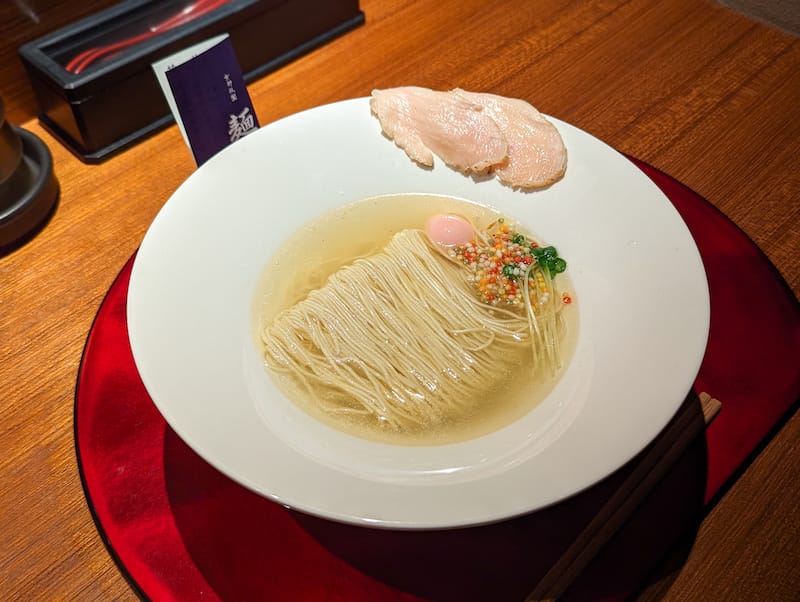
The attention to detail and quality is outstanding. We are compelled; we want to know more about the ingredients and so we ask about the kodawari, which translates roughly as the store’s speciality, the thing they’re most particular about. It’s often a dedicated page on restaurant menus, boasting the providence of each ingredient and the amount of hours spent on preparing something in an exact and exacting way.
But Mendori Hyakkei is no ordinary ramen place, and the answer doesn’t even touch on the cooking.
“Kodawari?” Ofuji smiles. “I would say that we are thankful that our customers have chosen to eat our ramen as their meal for that day and let us provide that for them. We’re so glad if they thought it was delicious and their day became better because of that.”
Otsubo nods in agreement. “It’s also a place where you can come to eat slowly. There’s no clock in here. It’s a place where you can forget the passing of time and just enjoy.”
All of this might seem counterintuitive to the ramen business model. If the store’s popularity grows, which it surely will, queues might put paid to hour-long lunches. Mendori Hyakkei has already built up a strong following of regulars. The customers who were at the counter when we arrived are famous actors from Osaka, Otsubo tells us casually.
For now, Otsubo’s approach is working well for him. He says there’s still much to learn; he’s excited to experiment with new ingredients and add a few things to the menu as he goes. His underlying philosophy, however, remains unshakable. Whether it’s the food, the conversation or the element of performance as he and Ofuji prepare the dishes, Mendori Hyakkei has one goal. “Cuisine is not just about delicious food, but it’s about enjoyment and having a good time,” he says.
As we push back the noren curtain and emerge into the bright, bustling streets of Gion, we can safely say we agree.
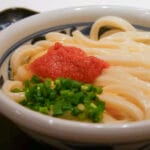 February 8, 2024 Taniya
February 8, 2024 Taniya
There’s a pocket of Tokyo, strolling distance from the stock exchange and the former […] Posted in Tokyo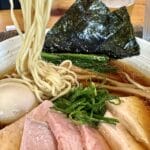 September 7, 2023 First Stop: Ivan Orkin’s Tokyo
September 7, 2023 First Stop: Ivan Orkin’s Tokyo
Editor’s note: In the latest installment of our recurring First Stop feature, we asked […] Posted in Tokyo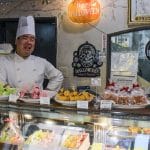 May 22, 2023 Ura Sablon
May 22, 2023 Ura Sablon
Ramen joints are often easily recognizable, either by large windows illuminating […] Posted in Tokyo
Published on November 28, 2023
Related stories
February 8, 2024
TokyoThere’s a pocket of Tokyo, strolling distance from the stock exchange and the former commercial center, which feels like a step back in time. Ningyocho is filled with stores specializing in traditional crafts, some more than 100 years old. Here you can buy rice crackers or traditional Japanese sweets or head for a kimono, before…
September 7, 2023
Tokyo | By Culinary Backstreets
TokyoEditor’s note: In the latest installment of our recurring First Stop feature, we asked chef and ramen expert Ivan Orkin about the first dishes he craves when he returns to Tokyo. Ivan is originally from the U.S. but has spent much of his life in the Japanese capital. He is the author of The Gaijin…
May 22, 2023
TokyoRamen joints are often easily recognizable, either by large windows illuminating slurping customers, a vending machine dispensing meal tickets at the doorway, or the brightly lit signs; usually it’s some combination of the three. When it comes to Ura Sablon, however, one might easily pass it by. The narrow entrance is tucked away between a…
















































